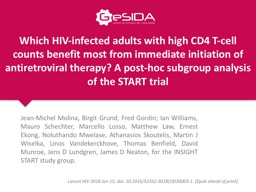

JeanMichel Molina Birgit Grund Fred Gordin Ian Williams Mauro Schechter Marcello Losso Matthew Law Ernest Ekong Noluthando Mwelase Athanasios ID: 1032236
Download Presentation The PPT/PDF document "Which HIV-infected adults with high CD4 ..." is the property of its rightful owner. Permission is granted to download and print the materials on this web site for personal, non-commercial use only, and to display it on your personal computer provided you do not modify the materials and that you retain all copyright notices contained in the materials. By downloading content from our website, you accept the terms of this agreement.
1. Which HIV-infected adults with high CD4 T-cell counts benefit most from immediate initiation of antiretroviral therapy? A post-hoc subgroup analysis of the START trialJean-Michel Molina, Birgit Grund, Fred Gordin; Ian Williams, Mauro Schechter, Marcello Losso, Matthew Law, Ernest Ekong, Noluthando Mwelase, Athanasios Skoutelis, Martin J Wiselka, Linos Vandekerckhove, Thomas Benfield, David Munroe, Jens D Lundgren, James D Neaton, for the INSIGHT START study group.Lancet HIV 2018 Jan 15; doi: 10.1016/S2352-3018(18)30003-1. [Epub ahead of print].
2. Resumen
3. BackgroundSTART has shown a net clinical benefit of immediate vs. deferred antiretroviral therapy (ART) in asymptomatic HIV-infected adults with CD4+ T-cells > 500/mm3 This relative clinical benefit was consistent across all baseline subgroups supporting the recommendation of universal treatment of HIV-infectionWe wished to assess whether some subgroups benefited more than others from immediate ART Such data may help doctors and policy makers to prioritize immediate ART in people with asymptomatic HIV-infection and high CD4+ counts
4. HIV-infected individuals who are ART-naïve with CD4+ count > 500 cells/mm3Immediate ART GroupInitiate ART immediately following randomizationN=2,326Deferred ART GroupDefer ART until CD4+ count <350 cells/mm3 or AIDSN=2,359Primary endpoint:Serious AIDSSerious non-AIDS conditions CVD (stroke, MI, revascularization), ESRD, decompensated liver disease, non-AIDS cancerAll-cause deathSTART Study Design
5. Baseline Characteristics-1
6. Baseline Characteristics-2
7. Subgroups were pre-specified for analysis by the protocol, except for the CD4:CD8 ratio (post-hoc). Within each subgroup, we estimated:Primary event rates per 100 PY HR (Imm/Def) (with 95% CI) using Cox modelsAbsolute risk reduction (ARR= rateDef – rateImm), using Wilson’s score method for the 95% CINumber need to treat immediately for one year to prevent one event compared with deferred ART, NNT=100/ARRHeterogeneity across subgroups was assessed using:Interaction tests in Cox models for the HRBootstrap tests for the ARR and NNTSubgroups with < 10 events (both arms combined) were not consideredMethods
8. START: Primary Endpoint
9. Hazard Ratios in Subgroups-1
10. Hazard Ratios in Subgroups-2
11. Primary Endpoint by AgeKaplan-Mejer Estimates
12. Primary Endpoint by CD4:CD8 RatioKaplan-Mejer Estimates
13. Primary Endpoint by HIV RNAKaplan-Mejer Estimates
14. Randomised designLarge sample sizeUniform reportingCentral adjudication of eventsStrenghts
15. Mean duration of follow-up was only 3.1 years and, consequently, event counts in most subgroups were small, particularly when considering the endpoints of AIDS and serious non-AIDS illnesses separately.Low event numbers in individual subgroups resulted in substantial uncertainty in estimates of absolute risk reduction, reflected by the large confidence intervals, and limited power to detect heterogeneity in treatment effect accross subgroups.There were many subgroups considered, some of them not prespecified, without adjustment for type I error, which might have lead to chance findings.Limitations
16. In asymptomatic ART-naïve adults with > 500 CD4 + cells/mm3, immediate ART was superior to deferred ART across all subgroups with similar relative risk reductionHigher absolute risk reduction and lower NNT were found in participants with: Age > 50 yearsPlasma HIV RNA level > 50,000 c/mLCD4:CD8 ratio < 0.5These patients might be prioritized for immediate access to ARTImmediate ART also reduces transmission risk which is essential for cost-effectiveness considerationsConclusions